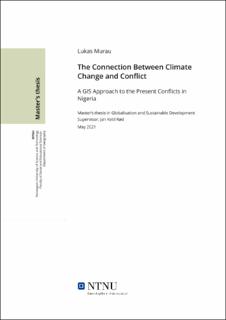| dc.description.abstract | During the recent years and in the shadows of the much-noticed activities of the terrorist group Boko Haram, clashes between Fulani herdsmen and farmers of various other ethnic groups have spiraled into a violent conflict in Nigeria, escalating in 2015 with four-digit death tolls in approximately 200 incidents. Research has so far addressed a wide range of hypotheses on the causes for this dispute, ranging from climate change to ethnic and religious confrontations as the consequence of a Muslim attempt to reach dominance over the Christian majority in the Nigerian Middle-Belt.
By using geoinformatics (GIS) as a set of tools, this master thesis aims at analyzing the causes of the conflict with a focus on climate change. Therefore, a spatio-temporal analytical framework is applied for the comparison of land cover changes in Ghana and Nigeria between 1992 and 2019 as well as of changes in temperatures, precipitation, and wet days for the period of 1971 to 2020. As the second step of the analysis, other factors without a connection to climate change are operationalized for the use in a regression analysis in ArcGIS in order to elaborate on the most important factors contributing to the herdsmen-farmers conflict. These factors include population growth, urbanization, access to water and the natural resources of petroleum and diamonds, ethnic dominance, road density, literacy, poverty, and terrain roughness on the second-order administrative level of Nigeria.
Consequently, this thesis finds that considerable areas of grass- and shrublands, which are suitable areas for cattle herding, are transformed into mostly rainfed agricultural farmlands and urban areas for the period until 2015. In the following years, an increased conversion from agricultural areas to other land types is observable. However, neither the land cover changes nor the moderate increase in temperatures, decrease in wet days, and the hardly identifiable change in precipitation differ considerably between Nigeria and Ghana. Nevertheless, the regression analysis identifies a statistical significance of temperature, precipitation, and wet days change for the conflict between herdsmen and farmers, along with the non-climate change-related factors population growth, poverty and literacy rates, as well as urban areas. | |
